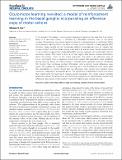| dc.contributor.author | Fee, Michale S. | |
| dc.date.accessioned | 2012-09-05T14:38:04Z | |
| dc.date.available | 2012-09-05T14:38:04Z | |
| dc.date.issued | 2012-06 | |
| dc.date.submitted | 2012-01 | |
| dc.identifier.issn | 1662-5110 | |
| dc.identifier.uri | http://hdl.handle.net/1721.1/72519 | |
| dc.description.abstract | In its simplest formulation, reinforcement learning is based on the idea that if an action taken in a particular context is followed by a favorable outcome, then, in the same context, the tendency to produce that action should be strengthened, or reinforced. While reinforcement learning forms the basis of many current theories of basal ganglia (BG) function, these models do not incorporate distinct computational roles for signals that convey context, and those that convey what action an animal takes. Recent experiments in the songbird suggest that vocal-related BG circuitry receives two functionally distinct excitatory inputs. One input is from a cortical region that carries context information about the current “time” in the motor sequence. The other is an efference copy of motor commands from a separate cortical brain region that generates vocal variability during learning. Based on these findings, I propose here a general model of vertebrate BG function that combines context information with a distinct motor efference copy signal. The signals are integrated by a learning rule in which efference copy inputs gate the potentiation of context inputs (but not efference copy inputs) onto medium spiny neurons in response to a rewarded action. The hypothesis is described in terms of a circuit that implements the learning of visually guided saccades. The model makes testable predictions about the anatomical and functional properties of hypothesized context and efference copy inputs to the striatum from both thalamic and cortical sources. | en_US |
| dc.description.sponsorship | National Institutes of Health (U.S.) (R01MH067105) | en_US |
| dc.language.iso | en_US | |
| dc.publisher | Frontiers Research Foundation | en_US |
| dc.relation.isversionof | http://dx.doi.org/10.3389/fncir.2012.00038 | en_US |
| dc.rights | Article is made available in accordance with the publisher's policy and may be subject to US copyright law. Please refer to the publisher's site for terms of use. | en_US |
| dc.source | Frontiers Research Foundation | en_US |
| dc.title | Oculomotor learning revisited: a model of reinforcement learning in the basal ganglia incorporating an efference copy of motor actions | en_US |
| dc.type | Article | en_US |
| dc.identifier.citation | Fee, Michale S. “Oculomotor Learning Revisited: a Model of Reinforcement Learning in the Basal Ganglia Incorporating an Efference Copy of Motor Actions.” Frontiers in Neural Circuits 6 (2012). | en_US |
| dc.contributor.department | Massachusetts Institute of Technology. Department of Brain and Cognitive Sciences | en_US |
| dc.contributor.department | McGovern Institute for Brain Research at MIT | en_US |
| dc.contributor.approver | Fee, Michale S. | |
| dc.contributor.mitauthor | Fee, Michale S. | |
| dc.relation.journal | Frontiers in Neural Circuits | en_US |
| dc.eprint.version | Final published version | en_US |
| dc.type.uri | http://purl.org/eprint/type/JournalArticle | en_US |
| eprint.status | http://purl.org/eprint/status/PeerReviewed | en_US |
| dspace.orderedauthors | Fee, Michale S. | en |
| dc.identifier.orcid | https://orcid.org/0000-0001-7539-1745 | |
| mit.license | PUBLISHER_POLICY | en_US |
| mit.metadata.status | Complete | |
